Best Preamps For Home Studio (2024 Update)
Setting up a home recording studio can be an exciting yet daunting task, especially when it comes to selecting the right audio equipment. A critical piece of gear that aspiring home studio owners need to carefully consider is the microphone preamplifier, commonly known as a preamp. Choosing the best preamp for your home studio setup requires taking into account factors like audio connectivity, gain control, noise levels, impedance matching, and compatibility with your audio interface and microphoneselection.
Before settling on a preamp model, ask yourself the following key questions: Will you need multiple channels to record vocals, instruments, and ambient sound simultaneously? Do you require studio-grade sound quality with minimal noise and distortion? What audio connectors and controls does your setup necessitate? Does the preamp offer 48V phantom power for condenser mics? Is it compatible with your computer’s operating system and digital audio workstation software? Getting the answers to these questions will steer you towards the ideal preamp that fulfills your home recording needs.
Investing in a high-quality, versatile preamp enables you to capture pristine audio takes to craft polished, professional recordings. Let your creative passion guide you as you search for the perfect preamp to build your home studio. The right gear choice gets your musical ideas flowing freely.
10 Best Preamps For Home Studio
| # | Product Image | Product Name | Product Notes | Check Price |
|---|---|---|---|---|
|
1
|
Ideal for enhancing sound quality and providing a warm, classic tone to audio recordings and live performances.
|
|
||
|
2
|
The product is ideal for enhancing the sound quality of professional microphones and instruments using a tube preamplifier with USB connectivity.
|
|
||
|
3
|
The product is ideal for enhancing the sound quality of studio microphones and instruments.
|
|
||
|
4
|
Ideal for home recording and producing high quality vocals with a compact all-in-one USB setup.
|
|
||
|
5
|
It is ideal for enhancing the sound quality of microphone recordings with a variable valve voicing tube and limiter.
|
|
||
|
6
|
This product is ideal for recording and playing audio from various sources such as Bluetooth, USB flash, and SD cards.
|
|
||
|
7
|
The product is ideal for improving the sound quality of recordings with its vacuum-tube technology and multiple audio processing features.
|
|
||
|
8
|
The product is ideal for isolating microphones and reducing unwanted noise or vibrations from the environment.
|
|
||
|
9
|
The product is ideal for improving microphone sound quality, reducing noise, and enhancing vocal clarity in recordings and live performances.
|
|
||
|
10
|
Ideal for improving microphone signal strength and clarity without adding noise or distortion, suitable for recording and live performances.
|
|
1. Presonus Tubepre V2 Tube Preamplifier Di Box
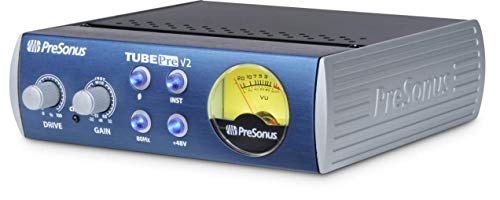
The 12AX7 tube-based preamp with an XMAX solid-state input stage is a powerful addition to any recording setup. With separate instrument and mic inputs, this preamp is versatile enough to handle a wide range of instruments and recording scenarios.
One of the standout features of this preamp is its gain control and tube drive saturation control. These controls allow for precise adjustments to the preamp's output, providing users with the ability to dial in the perfect tone for their recordings.
To ensure the highest possible level of audio quality, this preamp also features a low-noise dual-servo gain stage. This design eliminates the need for capacitors, resulting in a clean, accurate signal path that's free from unwanted noise and distortion.
In addition to its impressive audio capabilities, this preamp also includes a range of useful features for recording engineers. Phantom power, HP filter, -20 dB pad, and polarity-reverse are all included, providing users with the tools they need to capture high-quality recordings in any environment.
2. Art Tubemp Project Series With Usb Professional Microphone And Instrument Tube Preamplifier C
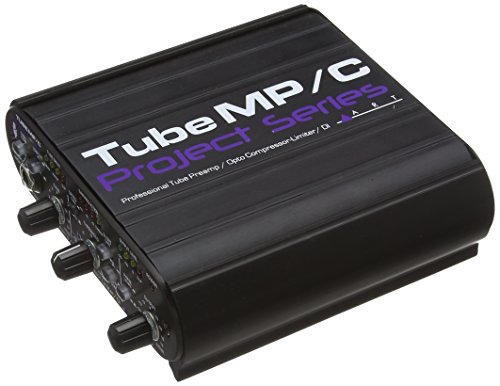
This product offers a clean, neutral sound that is compatible with a wide range of signal sources. It features high impedance 1/4" instrument inputs that are specifically optimized for guitar pickups, which allows for every nuance of the instrument to be heard. The product also includes a high quality 12AX7A tube that adds warmth to the musical dynamics.
The external power supply of the product ensures that AC line noise and hum are kept at bay and remain at the wall, providing a cleaner sound. The input gain control and switch allow for maximum input dynamic range and s control tube drive input.
3. Art Tube Mp Studio Mic Preamp
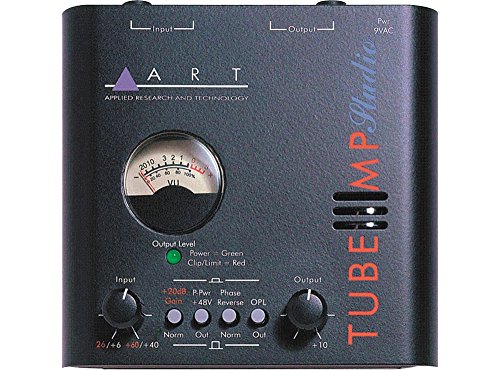
This professional-grade preamplifier is the perfect addition to any recording studio or live sound setup. It offers superior amplification for a variety of audio sources including microphones, instruments, and line level inputs. The hand-selected 12AX7A vacuum tube provides warm and rich tones, while the analog VU meter allows for accurate monitoring of input levels.
The preamp also boasts variable input and output gain controls, giving users the flexibility to adjust levels to suit their specific needs. Additionally, the OPL Output Protection Limiter ensures that the signal stays clean and distortion-free even at high volumes.
Whether you're recording vocals, guitar, or any other instrument, this preamp is sure to provide the high-quality sound you need to create outstanding recordings.
4. Talent All-In-One Usb Home Recording Studio – Vocal Booth – Usb Mic – Shock Mount – Pop Filter
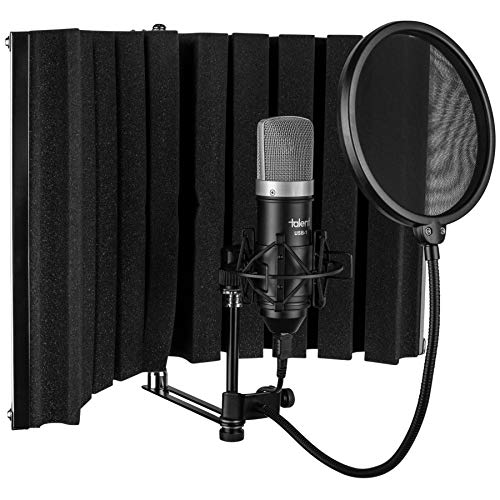
This package includes a high-quality USB microphone, isolation booth, shock mount, and pop filter – all designed to provide a clean and professional recording experience. The USB microphone is of superior quality and is ideal for capturing vocals, instruments, and podcasts with exceptional clarity and accuracy. The isolation booth ensures minimal background noise interference, while the shock mount minimizes any mechanical vibrations.
The pop filter, on the other hand, eliminates any popping sounds that could occur during recording. This set-up is affordable and provides all the necessary equipment for a professional recording experience, at less than the cost of a typical USB microphone.
The USB microphone is easy to attach to any microphone stand with a 5/8"-27 TPI attachment. And, with the addition of your favorite recording software, you'll have everything you need to get started and produce quality recordings.
5. Art Tubempstv3 Variable Valve Voicing Tube Mic Preamp With Limiter
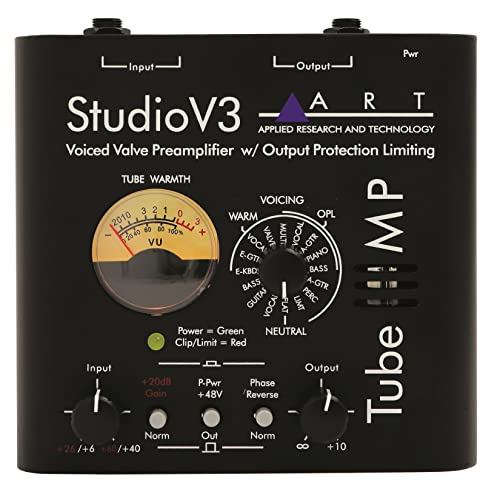
This product is built with superior quality and durability in mind. The dimensions of this product measure 5.0 inches in depth, 5.5 inches in width, and 2.0 inches in height, while weighing in at 1.5 lbs. Made with rugged all-steel construction, this product is designed to withstand the test of time and perform reliably for years to come. The manufacturer stands behind their product, offering a 1 year warranty to ensure customer satisfaction. Rest assured that this product has been crafted with the utmost care and attention to detail, providing you with a reliable and long-lasting solution.
6. Bluetooth Pre-Amp With Lcd Display & Remote
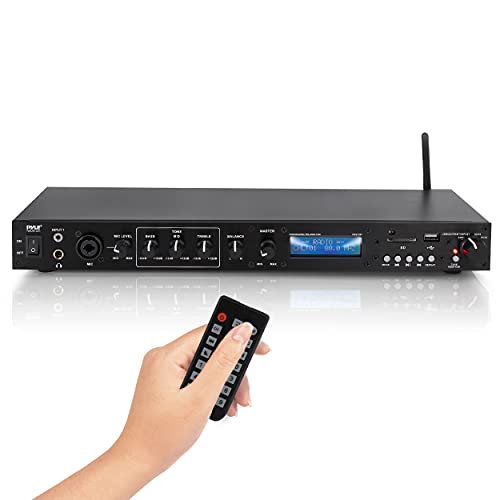
The Pyle Pro Audio Pre-Amplifier is a versatile and feature-packed device that is perfect for any music enthusiast. It is rack mount compatible and comes with detachable hardware rack mounts that make assembly quick and easy.
With built-in Bluetooth technology, this pre-amplifier allows for wireless music streaming from devices such as iPhones, Androids, smartphones, iPads, tablets, and computers. The Bluetooth feature has a range of up to 25+ feet and comes with a digital LCD display that makes it easy to use.
In addition to Bluetooth, this pre-amplifier also includes two sets of RCA inputs, an RCA preamp out, and two Mono RCA's for subwoofer output. It also has an FM antenna for better signal reception. The AUX input and output make it easy to connect to a variety of devices.
The front control center of the Pyle Pro Audio Pre-Amplifier includes a power switch, independent input source selectable, bass, treble, mid, balance, and master volume adjustment buttons. It also has a headphone jack, USB flash, and SD memory card readers. This makes it easy to control the sound and volume of your music.
A simple and user-friendly remote control is included with the Pyle Pro Audio Pre-Amplifier. The remote control provides all the functionality you need from switching input sources and allows you to access all functions of the receiver quickly and efficiently.
7. Presonus Studiochannel Vacuum-Tube

The High-voltage Class A 12AX7 vacuum-tube mic/instrument Preamplifier is a versatile and powerful piece of equipment that every musician and recording artist will appreciate. This preamplifier is equipped with a range of features that make it stand out from other preamplifiers on the market.
One of the key features of this preamplifier is its Gain and tube drive. The high voltage Class A 12AX7 vacuum-tube provides a warm and rich tone that is perfect for recording vocals, guitars, and other instruments. The tube drive feature allows users to control the amount of distortion in the signal, adding a desirable warmth and character to the sound.
The preamplifier also includes a HP filter and -20 dB pad. The HP filter helps to eliminate unwanted low-frequency noise, while the -20 dB pad is useful for recording high-output sources such as drums or loud guitar amplifiers. Additionally, it has Phantom power and polarity reverse, which are essential features for recording studio-quality vocals.
The 3-band EQ is another standout feature of this preamplifier. The mid-band is parametric and the low and high bands are semi-parametric, offering users a lot of flexibility in shaping their sound. The EQ also features variable-q on the mid-band with peak/shelving on high and low bands, giving users the ability to fine-tune their sound to perfection.
The preamplifier's Variable VCA compressor is also impressive, with auto attack/release and soft/hard knee features that allow for greater control over the dynamics of the signal. This feature is particularly useful for recording vocals or instruments with a wide dynamic range.
The preamplifier offers a range of inputs, including instrument, line, and mic inputs, making it compatible with a wide range of instruments and devices. The 1U 19” rack-mountable, rugged steel chassis is durable and built to last, making it a reliable piece of equipment for any recording studio.
8. Auray Iso-Armor-2 Microphone Isolation Chamber
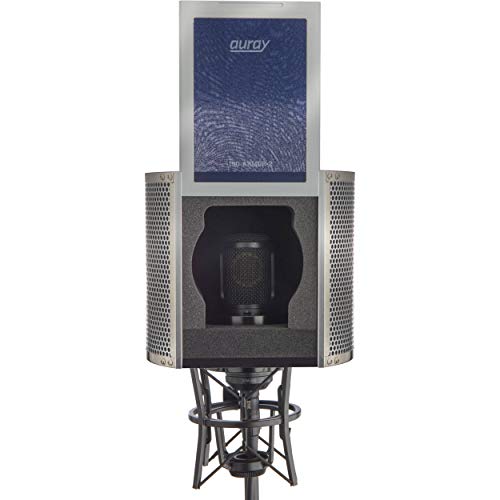
Introducing the ISO-ARMOR-2, a portable isolation tool designed specifically to reduce ambient noise and room reflections. The ISO-ARMOR-2 is made of high-density, open-cell acoustic foam that shields your microphone from unwanted indirect sounds, such as echoes bouncing from wall to wall and noise from fans or air conditioners. It fits microphone diameters up to 2.3 inches and weighs only 1.4 pounds, making it easily transportable and convenient to use without acoustic treatment.
The ISO-ARMOR-2 features a perforated aluminum shell that provides a modern look for in-studio photos, as well as additional protection against sonic degradation from undesired off-axis sounds. The integrated sliding pop filter, built with two-layer nylon material, minimizes destructive plosives, slides up and down for easy microphone access, and can be removed for close-proximity vocals.
The deep microphone chamber of the ISO-ARMOR-2 aids in achieving a focused vocal sound void of excessive coloration from flutter echo and room reverb. The included suspension mount neatly secures to the bottom of the ISO-ARMOR-2, keeping your microphone steady and stable while decoupling the mic from external vibrations and sympathetic resonance.
This portable isolation tool is perfect for those looking to improve their vocal tone during recording or live performances. It is lightweight and compact, making it easy to carry and set up anywhere. The ISO-ARMOR-2 provides convenient, space-efficient isolation from distracting room noise and reflections, allowing for a more dry, direct sound.
9. Dbx 286s Microphone Preamp &
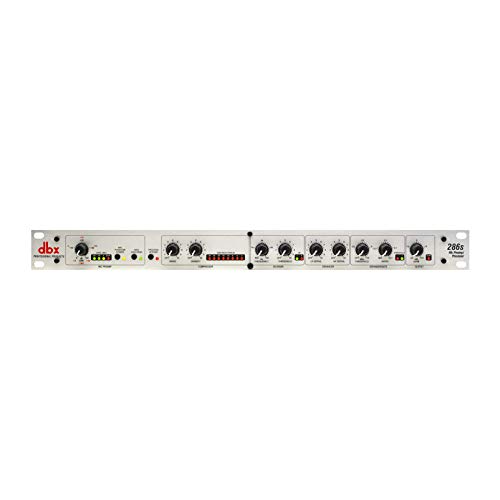
The dbx286s is a top-of-the-line mic preamp and channel strip processor that delivers studio-quality sound with ease. Equipped with classic dbx compression, this processor allows users to achieve great sound effortlessly. It also features a frequency tuneable de-esser that effectively reduces sibilance and high frequency distortion, resulting in a clear and crisp sound.
To further enhance audio quality, the dbx286s comes with an enhancer that increases the detail and definition of the high and low frequencies. Additionally, this processor boasts a program adaptive expander/Gate that provides added flexibility in audio processing. The frequency response of the dbx286s ranges from 20Hz to 20kHz, ensuring that no audio detail is lost.
The dbx286s offers multiple input options including two 1/4" TRS and one XLR, and one 1/4" TRS output. Moreover, this processor is designed to operate on different voltages, including 120VAC 60Hz and 100VAC 50/60Hz, making it ideal for use in various locations.
In the package, customers will receive the dbx286s, a power cord, an operation manual, and four rack mount screws and washers. The dbx286s is easy to set up and use, making it an excellent choice for both beginners and professionals in the music industry.
10. Cloud Microphones – Cloudlifter Cl-1 Mic Activator – Ultra-Clean Microphone Preamp Gain – Usa Made
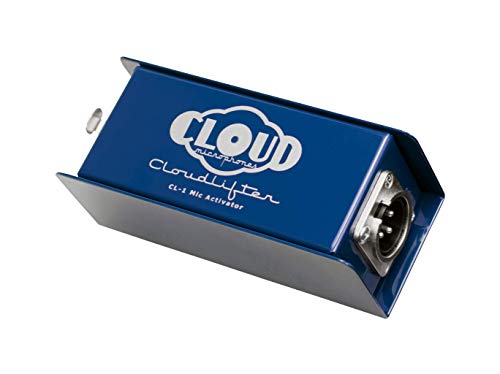
The Cloudlifter CL-1 mic activator is a powerful tool for both home studios and professional recording environments. Its ability to boost the signal of quiet audio sources like vocals, percussion, or acoustic instruments while maintaining the natural sound of your microphone makes it an essential piece of equipment for anyone looking to enhance their recordings.
Not only does the Cloudlifter CL-1 increase signal strength, but it also reduces unwanted noise and feedback, resulting in increased microphone clarity. The use of Phantom power allows for passive mics to be boosted up to +25dB without passing Phantom power onto the mics themselves, ensuring the safety of your equipment.
This home studio equipment is perfect for a variety of uses, including podcasts, live streaming, radio broadcasts, live sound, and studio recording. Its seamless integration with your preamp ensures ease-of-use for any professional.
The Cloudlifter CL-1 is also highly compatible, working with tube, battery, or power supply driven microphones. It is safe for all passive ribbons with no transfer of Phantom power, making it a versatile accessory for any recording setup.
For podcasters, the Cloudlifter CL-1 is an essential tool for achieving professional-level sound quality. Its ability to instantly improve the sound of your production makes it a must-have accessory for creators looking to take their content to the next level.
Best Preamps For Home Studio FAQs
Are budget preamps worthwhile for home studio recording, or should I invest in higher-end options?
When it comes to preamps for home studio recording, the decision between budget and higher-end options ultimately depends on your specific needs and goals. Budget preamps can certainly get the job done and provide a decent sound quality for basic recordings. However, if you are looking to achieve a more professional sound and have the budget to invest in higher-end options, it may be worth considering.
Higher-end preamps often have better components and construction, resulting in a more transparent and detailed sound. They may also offer more features and flexibility in terms of tonal shaping and connectivity options.
That being said, it's important to remember that the preamp is just one component in the recording chain. The quality of your microphones, interface, and recording environment can also have a significant impact on the final product.
In summary, if you are a beginner or working on basic recordings, a budget preamp can suffice. However, if you are looking to take your recordings to the next level and have the means to invest in higher-end options, it may be worth considering.
Are tube preamps better than solid-state preamps for home studio use?
The answer to this question depends on personal preference and the specific needs of the home studio setup. Both tube preamps and solid-state preamps have their advantages and disadvantages.
Tube preamps are known for their warm, vintage sound and natural compression. They can add a pleasing coloration to the sound and are often preferred for recording vocals and acoustic instruments. However, they can also add noise and require more maintenance and upkeep compared to solid-state preamps.
Solid-state preamps, on the other hand, are known for their clean, transparent sound and low noise levels. They are often preferred for recording electric instruments and drums, as they can capture the full range of frequencies without adding any coloration. They also require less maintenance and are generally more affordable than tube preamps.
Ultimately, the choice between tube preamps and solid-state preamps comes down to personal preference and the specific needs of the home studio setup. It is recommended to try out both types of preamps and see which one best suits your recording style and needs.
Can I use a preamp with USB connectivity for home studio recording?
Yes, you can use a preamp with USB connectivity for home studio recording. In fact, preamps with USB connectivity have become increasingly popular in recent years due to their convenience and ease of use. These preamps typically come equipped with high-quality analog-to-digital converters that allow you to capture high-quality audio directly to your computer.
One of the main benefits of using a preamp with USB connectivity is that it eliminates the need for a separate audio interface. This can be especially helpful if you're working with limited space or a tight budget. Additionally, many USB preamps offer a range of features and controls that allow you to fine-tune your recordings and achieve the exact sound you're looking for.
When choosing a preamp with USB connectivity, it's important to consider factors such as the number of inputs and outputs, the quality of the preamp circuitry, and the overall build quality. It's also important to choose a preamp that is compatible with your recording software and operating system. With the right preamp, you can achieve professional-quality recordings in the comfort of your own home studio.
Can I use my audio interface's built-in preamps, or should I invest in dedicated preamps for my home studio?
The answer to this question depends on the quality and intended use of your recordings. If you are recording basic voiceovers or podcasts, the built-in preamps on your audio interface may be sufficient. However, if you are recording music or other professional-level audio, investing in dedicated preamps can greatly improve the quality of your recordings.
Dedicated preamps offer higher quality and clarity than built-in preamps, and can also provide more control over the sound. Additionally, dedicated preamps can help reduce noise and interference, leading to a cleaner recording.
It's important to note that investing in dedicated preamps can be expensive, so it's important to consider your budget and intended use before making a decision. If you're just starting out, it may be more practical to use your audio interface's built-in preamps and upgrade later if necessary.
Ultimately, the decision to use built-in preamps or dedicated preamps depends on your goals and budget. It's always a good idea to do research and consult with experienced professionals to make an informed decision.
How do I properly set up and use preamps in my home recording studio?
Preamps play a crucial role in home recording studios as they help to boost the signal from your microphone or instrument to a level that can be recorded by your audio interface or mixer. To properly set up and use preamps in your home recording studio, follow these steps:
1. Choose the Right Preamp: Select a preamp that matches the impedance of your microphone or instrument to ensure optimal sound quality.
2. Connect Your Preamp: Connect your preamp to your audio interface or mixer using a balanced XLR cable.
3. Adjust the Gain: Set the gain on your preamp to an appropriate level to prevent distortion or clipping.
4. Monitor Your Sound: Use headphones or studio monitors to monitor your sound and make adjustments to the gain as needed.
5. Experiment with Different Settings: Try adjusting the gain, EQ, and other settings on your preamp to achieve the desired sound for your recording.
Overall, setting up and using preamps in your home recording studio requires careful attention to detail and a willingness to experiment with different settings to achieve the best possible sound quality.
How do preamps improve the sound quality of recordings in a home studio?
Preamps play a vital role in improving the sound quality of recordings in a home studio. They are responsible for amplifying the weak signals from microphones and other audio sources before they are recorded by the digital audio workstation (DAW). By doing so, they increase the level of the audio signal and reduce the noise floor, resulting in a cleaner and more detailed sound.
Preamps also add color and character to the sound, which can be especially useful when recording vocals or acoustic instruments. They can add warmth, depth, and richness to the sound, making it more pleasing to the ear.
In addition, preamps can provide additional features such as phantom power, which is necessary for powering condenser microphones. They can also provide high-pass filters and phase switches, which can be used to eliminate unwanted frequencies and correct phase issues.
Overall, using a high-quality preamp can make a significant difference in the sound quality of recordings in a home studio. It can help to capture the nuances and subtleties of the performance, resulting in a more professional and polished final product.
What are the top-rated preamps for home studio recording?
When it comes to home studio recording, having a high-quality preamp can make a significant difference in the output of your recordings. There are several top-rated preamps that are worth considering for your home studio setup.
One of the most popular preamps is the Universal Audio Apollo Twin MKII. This preamp offers excellent sound quality and features a range of digital effects and processing options. Another great option is the Focusrite Scarlett 2i2, which is known for its ease of use and affordability. The Audient iD4 is also a highly regarded preamp that offers excellent sound quality and a compact design.
If you're looking for a more high-end preamp, the API 3124+ is a popular choice among professional studios. This preamp is known for its rich and warm sound and features four channels for recording multiple instruments simultaneously. The Neve 1073 is another high-end preamp that is often used for recording vocals and acoustic instruments.
Ultimately, the best preamp for your home studio will depend on your specific needs and budget. It's important to do your research and read reviews before making a purchase to ensure that you're getting the best quality preamp for your money.
What features should I look for when choosing a preamp for my home studio setup?
When choosing a preamp for your home studio setup, there are several features that you should consider to ensure that you get the best possible sound quality. Here are some of the key features you should look for:
1. Gain control: This allows you to adjust the signal level to match your recording equipment and ensures that you can achieve optimal recording levels.
2. Noise level: Look for preamps that offer a low noise floor to ensure that your recordings are free of unwanted noise.
3. Frequency response: Check the frequency response of the preamp to ensure that it can handle the full range of your recording equipment.
4. Input/output options: Consider the type of inputs and outputs that the preamp offers and make sure they match your recording equipment.
5. Versatility: Look for preamps that can handle a wide range of recording applications, such as vocals, guitars, and drums.
6. Brand reputation: Do your research on the brand and read reviews from other users to ensure that you are investing in a quality preamp.
By considering these features, you can choose a preamp that will help you achieve high-quality recordings in your home studio setup.
What is the difference between a microphone preamp and a line-level preamp?
A microphone preamp and a line-level preamp are two pieces of audio equipment that are used to amplify audio signals, but they serve different purposes and have different features.
A microphone preamp is designed to amplify the low-level signals that come from a microphone. Microphone signals are very weak and require a preamp to boost the signal to a level that can be used by other audio equipment. Microphone preamps are typically designed to provide a lot of gain, so that even very quiet sounds can be amplified without adding noise or distortion.
A line-level preamp, on the other hand, is designed to amplify signals that are already at a higher level, such as signals from CD players, synthesizers or other audio equipment. Line-level signals are much stronger than microphone signals, so line-level preamps typically provide less gain than microphone preamps. However, line-level preamps often have additional features such as tone controls or EQ that allow the user to shape the sound of the signal.
In summary, a microphone preamp is used to amplify the weak signals from a microphone, while a line-level preamp is used to amplify signals that are already at a higher level.
What is the ideal number of preamp channels for a home recording studio?
The ideal number of preamp channels for a home recording studio depends on the individual needs and goals of the studio. Generally, a home recording studio may require anywhere from 2 to 8 preamp channels. If you plan on recording solo artists like singers or guitarists, 2 channels may suffice. However, if you plan on recording a full band, you will need at least 4 channels or more. It's important to consider the type of music you will be recording and the number of instruments involved. Additionally, the budget of the studio also plays a role in determining the number of preamp channels. A larger budget may allow for more channels, while a smaller budget may require the use of fewer channels. It's important to weigh the options and determine what will work best for your specific needs and goals.







